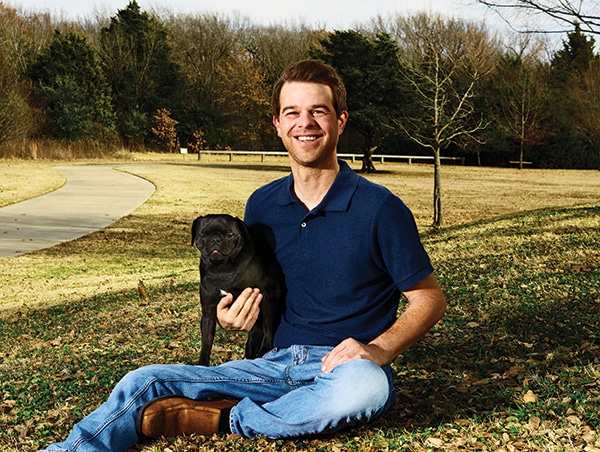There aren’t many people who have navigated not one but two complicated gastrointestinal problems before their 35th birthday.
North Texas native Roy Whittington has done just that and considers himself lucky. At 34, he became one of the youngest patients at Methodist Richardson Medical Center to have the Whipple procedure (also known as a pancreaticoduodenectomy).
“When I tell people my story, they are surprised at how positive I am,” Roy says. “The way I see it, I’m lucky to be alive. Being upbeat is just part of making the most out of life.”
Acting drunk
Roy’s first health challenge was the most unusual. In 2015, he had episodes when he’d act drunk without having consumed any alcohol. Over the next few years, the people closest to him began to think he had secretly become addicted to alcohol.
“You can’t imagine what it’s like to try and explain your ‘drunk’ symptoms when you haven’t been drinking,” Roy says. “Not knowing what was going on with my body, not being believed by my loved ones, not wanting to go out in public or drive because I was fearful I’d have an episode … it was all very depressing.”
When he began having small seizures on the right side of his body, he knew it was time to find answers. After dozens of appointments and tests, Roy was diagnosed with an extremely rare condition known as auto-brewery syndrome (ABS).
Roy was shocked to learn that his gut was turning carbs and sugar into alcohol.
“Once I was diagnosed, everything changed,” Roy says. “My family and friends finally understood. I went on a keto-like diet, and after two rounds of a strong antibiotic, I was cured of ABS.”
A second medical mystery
After feeling healthy and normal for a few years, Roy didn’t know what to think when he started having painful attacks in his upper abdomen.
“I just chalked it up to stomach pains,” Roy says. “Even as the months went by and the attacks got worse and started to include vomit and diarrhea, I never thought it was something serious.”
Then an attack came that had him bedridden for five days.
“I knew I had to get help, so I went to a nearby urgent care,” Roy says. “They informed me I had symptoms of chronic pancreatitis, which means your pancreas is inflamed. They advised me to see my primary doctor for a CT scan. When it was discovered I had three suspicious cysts in my pancreas, I was referred to Dr. Osman.”
Houssam Osman, MD, surgeon on the medical staff at Methodist Richardson Medical Center, ordered a battery of tests to help determine what was happening in Roy’s pancreas. The results were shocking.
“I was floored when Dr. Osman told me that there were abnormal, precancerous cells in the cysts,” Roy says.
Dr. Osman explained to Roy that his greatest concern was that the cells could turn into pancreatic cancer cells at any point. He then detailed Roy’s best option for staying cancer-free — a complex surgery called the Whipple procedure.
“I never want my patients to feel as though I’ve made a treatment decision for them, especially when we are talking about a technically challenging surgical procedure like Whipple,” Dr. Osman says. “My goal is to help them thoroughly understand their disease and the benefits and risks of their treatment options.”
The right place for a hard choice
After learning the details of the Whipple procedure, Roy was very concerned. Dr. Osman would have to remove the head of his pancreas, duodenum (the first part of the small intestine), gallbladder, bile duct, and half of his stomach.
“The most controllable factor of a Whipple procedure is choosing the right hospital,” says Dr. Osman. “A high-volume hospital with a multi-disciplinary surgical team, including postoperative care staff, is going to be the biggest contributor to a patient’s successful recovery.”
“My care was nothing short of incredible, and I’m forever grateful.” — Roy Whittington
When Roy agreed to have surgery, he knew he wasn’t just trusting Dr. Osman, he was also placing his trust in Methodist Richardson.
On May 3, 2019, Dr. Osman performed the six-hour surgery, which was made even more challenging due to significant scarring around his pancreas from his previous pancreatitis attacks.
“Recovering from the surgery was intense,” Roy says. “Looking back, it makes sense why Whipple patients need a skilled team for proper care after the procedure. My care was nothing short of incredible, and I’m forever grateful.”
Now that he is healthy again, Roy spends as much time with his loved ones as he can. Cooking as a group, family game nights, and getting their pups together are the things that make life good again for Roy.
“I’ve definitely not had the greatest luck with my health, but I refuse to be anything but positive,” Roy says. “All I wanted was to wake up from my surgery to see my brother and parents again. I got my wish, and I don’t intend to waste it.”
Get Shine Online delivered to your inbox!

